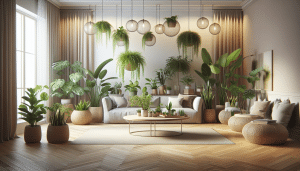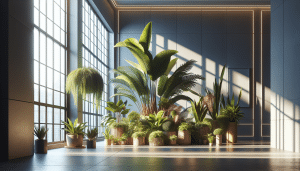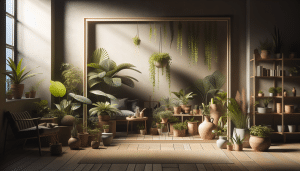You Could Transform Your Space With These Sustainable Garden Upgrades
Daniel Fisher September 17, 2025
Explore creative ways to boost your home’s curb appeal and create an eco-friendly oasis. This guide unveils practical and beautiful garden upgrades, using sustainable landscaping, native plants, and clever design choices so you can experience a more vibrant and efficient outdoor space.
The Benefits of Sustainable Landscaping
Adopting sustainable landscaping goes beyond enhancing visual appeal. For many homeowners, switching to eco-friendly gardening methods delivers rewards for both the household and the planet. Embracing native plants, rain gardens, and resource-saving irrigation methods can lower water costs, attract pollinators, and reduce the need for synthetic fertilizers. These changes also create healthier environments for children, pets, and local wildlife. The cumulative impact of sustainable gardening reaches far past the property line, allowing home gardens to play a role in broader ecological health.
Conventional landscapes often rely heavily on water, fertilizer, and labor-intensive lawn maintenance. By choosing drought-tolerant plants and implementing mulching strategies, it becomes possible to dramatically cut down on regular yard work, conserve water, and reduce emissions from gas-powered lawn equipment. In addition, sustainable gardens tend to be more resilient to pests and disease, often bouncing back with less intervention compared to traditional lawns. For residents looking to maximize value, making these upgrades also increases their home’s attractiveness to environmentally conscious buyers.
The ripple effect of sustainable landscaping doesn’t stop at personal convenience or savings. Rain gardens help manage stormwater runoff and prevent soil erosion, especially in neighborhoods where pooling or drainage issues are common. Butterfly and bee gardens provide food and shelter to crucial pollinators, supporting the entire regional food chain. While small, individual practices accumulate into larger changes, sustainable gardening continues to offer benefits for communities. Learn more about the big-picture gains from organizations such as the EPA and National Wildlife Federation (https://www.epa.gov/green-infrastructure/what-green-infrastructure).
Choosing Native Plants For Your Garden
Native plants are becoming a go-to choice for gardeners who value both function and beauty. Unlike exotic species, native varieties are adapted to the climate, require less watering, and resist local pests. When planted in the right location, they usually thrive with minimal intervention. This not only eases the gardener’s workload but also reduces the chemical load that would otherwise enter the soil and groundwater. Native plants support the region’s wildlife, offering a reliable food source for birds, butterflies, and bees that evolved alongside them.
While some might assume ‘native’ restricts the design palette, there are native flowering shrubs, perennial wildflowers, and ornamental grasses in every color, height, and texture imaginable. Careful selection and placement can provide year-round color and structure to the landscape. Consulting local extension offices or nature conservation groups can help identify the best options. As garden projects are planned, it’s helpful to observe which plants perform best in public parks, as these often use native mixes. Find lists of recommended species on university horticulture sites and local botanical gardens.
Native plants have another environmental bonus: They promote healthy soil. Their deep roots improve water infiltration and prevent surface runoff, reducing erosion after heavy rain. This natural stability also lowers the risk of landslides on slopes. Integrating native species across garden beds, borders, and naturalized areas combines low maintenance with maximum impact, creating a landscape that looks appealing and works with the environment. For a deeper dive, the Lady Bird Johnson Wildflower Center provides extensive native plant info (https://www.wildflower.org/).
Low-Water Gardening Solutions
Water-wise gardening is essential as cities and towns face growing drought periods and rising water bills. Minimizing thirsty lawn areas by adding garden beds filled with drought-tolerant shrubs, succulents, and groundcovers creates visual interest and significantly reduces irrigation needs. Some regions even offer rebates or incentives for replacing lawns with low-water alternatives. The key is proper plant selection matched to sun exposure, soil, and drainage—check with local gardening resources for tested combinations that excel in the local microclimate.
Mulching garden beds with organic matter such as shredded bark, leaves, or compost prevents moisture loss and naturally suppresses weeds. Drip irrigation systems or soaker hoses further boost water efficiency by delivering moisture directly to plant roots without evaporation loss. Seasonal watering adjustments are easier with modern smart controllers, which measure rainfall and soil moisture and adjust schedules automatically. These upgrades often pay for themselves in just a few seasons through lower water costs, so it makes sense to investigate options that will work for almost any garden.
Incorporating rain barrels and bioswales also supports responsible water use. Rain barrels collect water for use during dry spells, while bioswales—shallow landscape features designed to manage water runoff—filter and slow stormwater before it enters the groundwater system. These strategies are especially valuable in areas with strict watering limits or frequent droughts. Visit municipal water departments or university extension services to learn about available programs and resources for water-wise gardening (https://www.epa.gov/watersense/what-plant).
Clever Ways to Attract Pollinators
Pollinator-friendly gardens bring a burst of life to outdoor spaces. Simple techniques—like planting clusters of flowering species and ensuring bloom time extends across seasons—can draw butterflies, bees, and hummingbirds in abundance. Even small yards and balconies benefit from container gardens filled with pollinator favorites. Aromatic herbs, milkweed, and coneflowers are popular choices. It’s also helpful to provide shallow dishes of water and avoid using pesticides or herbicides, which can discourage or harm vital pollinators.
Pollinator habitats don’t have to look wild or unkempt. Structural plantings and neat borders keep gardens tidy while supporting beneficial insects. Adding bug hotels, bundles of hollow sticks, or patches of bare earth for ground-nesting bees also improves garden health. Many public gardens provide inspiring examples of pollinator-focused design with educational signage explaining plant-pollinator relationships. Home gardeners can mirror these layouts for optimal effect. These design ideas produce more flowers, fruit, and seeds throughout the year.
Native trees and shrubs often supply important resources when annual flowers have faded. Hawthorns, dogwoods, and wild plums offer nectar, pollen, and safe nesting spots from late fall to spring. Integrating different heights with layered planting maximizes the usable space for pollinators. For more on pollinator support, see guidance from Xerces Society and the USDA’s pollinator resources (https://xerces.org/pollinator-resource-center).
Composting and Soil Health at Home
Healthy soil is the foundation of every garden upgrade. Backyard composting transforms kitchen scraps, leaves, and yard waste into a nutrient-rich soil amendment. By maintaining a balance of green and brown materials and turning the pile regularly, it’s possible to produce rich, crumbly compost that boosts plant growth without resorting to chemical fertilizers. Composting is accessible to beginners—starter bins come in many sizes and can fit almost any property.
A thriving compost pile supports friendly microorganisms and beneficial insects, which in turn improve soil structure and fertility. Homemade compost suppresses soilborne diseases and increases the ground’s ability to retain water, both key factors in the success of sustainable gardens. Some cities or cooperative programs offer free or discounted compost bins, or workshops to help homeowners get started. For those with limited space, worm bins and bokashi systems provide compact composting alternatives.
Not every material should enter the compost—avoid meat, dairy, and oils alongside diseased plants. Instead, focus on yard clippings, vegetable peels, eggshells, coffee grounds, and autumn leaves. Finished compost can be worked into garden beds, side-dressed around trees, or spread as mulch. Over time, gardens become lusher and more resilient, and landfill waste shrinks. Learn composting basics from the Environmental Protection Agency and trusted gardening resources (https://www.epa.gov/recycle/composting-home).
Designing for Visual Impact and Wellness
Great gardens invite people outside. Using sustainable materials and native greenery doesn’t mean giving up style—quite the opposite. Layered planting, winding paths, and seating areas crafted from recycled or locally sourced materials add dimension and comfort. Combining sensory elements (like rustling grasses and fragrant blooms) with thoughtful lighting transforms the garden into a restful retreat. Studies have shown that time in green spaces supports mental health, lowers stress, and fosters overall wellness for inhabitants (https://www.ncbi.nlm.nih.gov/pmc/articles/PMC5663018/).
Lighting and seasonal décor allow gardens to shine all year. Solar or LED lights illuminate walkways and highlights, while shade structures enhance usability on hot afternoons. Incorporating edible plants within the landscape—herbs, berry bushes, or even fruit trees—can be both beautiful and productive. The trend toward multifunctional, edible landscapes is growing, encouraging homeowners to make the most of every square foot. Raised beds, trellises, and container gardens make participation easy regardless of garden size.
Ultimately, every sustainable garden upgrade combines aesthetics, function, and care for the ecosystem. Choosing permeable paving, rain gardens, and low-maintenance plantings frames the outdoor living area and supports climate resilience. Wellness-oriented garden design is as much about the experience as the look—an invitation to connect with nature at home. Design resources and inspiration can be tapped from organizations such as the American Society of Landscape Architects (https://www.asla.org/residentialinfo.html).
References
1. U.S. Environmental Protection Agency. (n.d.). What is Green Infrastructure? Retrieved from https://www.epa.gov/green-infrastructure/what-green-infrastructure
2. Lady Bird Johnson Wildflower Center. (n.d.). Native Plants. Retrieved from https://www.wildflower.org/
3. U.S. Environmental Protection Agency. (n.d.). What To Plant: WaterSense. Retrieved from https://www.epa.gov/watersense/what-plant
4. Xerces Society. (n.d.). Pollinator Resource Center. Retrieved from https://xerces.org/pollinator-resource-center
5. U.S. Environmental Protection Agency. (n.d.). Composting at Home. Retrieved from https://www.epa.gov/recycle/composting-home
6. Cox, D., et al. (2017). Doses of Nearby Nature Simultaneously Associated with Multiple Health Benefits. International Journal of Environmental Research and Public Health, 14(2), 172. Retrieved from https://www.ncbi.nlm.nih.gov/pmc/articles/PMC5663018/








